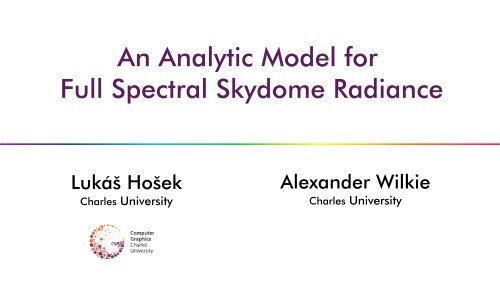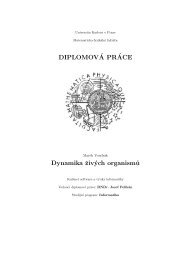SIGGRAPH 2012 presentation slides
SIGGRAPH 2012 presentation slides
SIGGRAPH 2012 presentation slides
You also want an ePaper? Increase the reach of your titles
YUMPU automatically turns print PDFs into web optimized ePapers that Google loves.
An Analytic Model for<br />
Full Spectral Skydome Radiance<br />
Lukáš Hošek<br />
Charles University<br />
Alexander Wilkie<br />
Charles University
• outdoor scenes<br />
Motivation: Skydome models<br />
• prediction of material appearance<br />
• architecture, outdoor scenes<br />
• alternative: skyboxes
The Preetham Model<br />
• De facto standard analytic skydome model<br />
• Simple closed form formulas<br />
• Outputs tristimulus data, convertible to spectral<br />
• Perez formula, fitted to the outputs of Nishita model<br />
• Fitting results publicly available<br />
luma distribution parameters<br />
B/cos θ D 2<br />
<br />
F( θ, γ) = 1+Ae 1+ Ce γ + Ecos<br />
γ<br />
solar angle<br />
zenith angle
inputs<br />
once per scene<br />
The Preetham Model<br />
θ <br />
3<br />
S<br />
0.00166 -0.00375 0.00209 0<br />
2 <br />
2<br />
θS<br />
x z = T T 1<br />
<br />
-0.02903 0.06377 -0.03202 0.00394<br />
<br />
<br />
<br />
θ <br />
S<br />
0.11693 -0.21196 0.06052 0.25886<br />
<br />
<br />
1 <br />
F (θ,γ)<br />
A,B,C,D,E<br />
x = x z·<br />
F A,B,C,D,E (0,γ s)<br />
output zenith angles<br />
A 0.1787 -1.4630<br />
<br />
B<br />
<br />
-0.3554 0.4275<br />
<br />
T C = -0.0227 5.3251 <br />
1<br />
<br />
<br />
<br />
D<br />
<br />
0.1206 -2.5771<br />
<br />
<br />
E <br />
<br />
<br />
-0.0670 0.3703<br />
<br />
zenith luminance luma distribution parameters<br />
for each sample<br />
turbidity<br />
solar-zenith angle
Issues With the Preetham Model<br />
• Simple functions for calculating zenith luminance and<br />
luma distribution parameters<br />
• Only a small subset of possible atmospheric conditions<br />
can be captured<br />
• Lack of localised aureole at higher turbidities<br />
• Spectral data are obtained by conversion from trisitmulus<br />
data
Issues with the Preetham Model
• spectral (including UV)<br />
• larger range of turbidities<br />
• eliminate artifacts<br />
Goals for the New Model<br />
• ground albedo (came later & almost for free)
Obtaining Reference Data<br />
• Brute force Monte Carlo path tracer that incorporates<br />
• Mie scattering<br />
• Rayleigh scattering<br />
• Albedo & colour of Earth surface<br />
• Delta scattering<br />
• Approaches the simulation as a transport problem, the<br />
same way physicists simulate e.g. gamma rays passing<br />
through containment shells of nuclear reactors
Obtaining Reference Data
Result: Raw Data
Result: Comparison
χ(g,α) =<br />
Modified formulas for a better fit<br />
B/cos θ D 2<br />
<br />
F( θ, γ) = 1+ Ae 1+Ce γ + Ecos<br />
γ<br />
B 1<br />
<br />
cosθ+0. 01<br />
Eγ 2<br />
2<br />
F(θ, γ) = 1+ Ae · C+ De + F cos γ +G χ(H,γ) +I cos θ<br />
<br />
<br />
2<br />
1+cosα<br />
3<br />
2 2<br />
(1+g -2g·cos α)<br />
fudge factor to prevent<br />
divergence to infinity<br />
at zenith<br />
anisotropic term<br />
for luminance peaks<br />
around sun<br />
original Perez formula<br />
supresses luminance peak<br />
exending too far up<br />
modified formula
inputs<br />
Model flowchart<br />
once per scene<br />
for each sample<br />
x z = B M (η,α, T)<br />
r<br />
solar elevation<br />
albedo<br />
turbidity<br />
mean radiance radiance distribution parameters<br />
x = x ·F (θ,γ)<br />
z A, B, ,I<br />
output<br />
A <br />
<br />
B<br />
<br />
= B M (η,α, T)<br />
d <br />
<br />
I
How the Fitting was Done<br />
• Levenberg-Marquardt nonlinear optimization<br />
• Yields a mean radiance and radiance distribution array<br />
• These are then used as control points for Bezier<br />
interpolation<br />
• Albedo 0-1<br />
Turbidity 1-10<br />
Solar elevation 0-90°<br />
320nm – 720nm bands, 40nm increment
Results
Sky Colour Patterns (sunset)
UV & Fluorescence
Ground Albedo<br />
black white<br />
water blue forest green
Conclusion<br />
• Reference implementation and data available for<br />
download<br />
• Version 1.1 out!<br />
• http://cgg.mff.cuni.cz/projects/SkylightModelling/
















